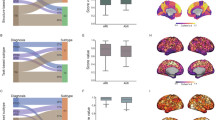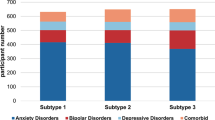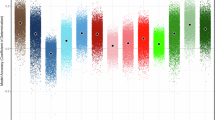Abstract
Depression is a common psychiatric illness that often begins in youth, and is sometimes associated with cognitive deficits. However, there is significant variability in cognitive dysfunction, likely reflecting biological heterogeneity. We sought to identify neurocognitive subtypes and their neurofunctional signatures in a large cross-sectional sample of depressed youth. Participants were drawn from the Philadelphia Neurodevelopmental Cohort, including 712 youth with a lifetime history of a major depressive episode and 712 typically developing (TD) youth matched on age and sex. A subset (MDD n = 368, TD n = 200) also completed neuroimaging. Cognition was assessed with the Penn Computerized Neurocognitive Battery. A recently developed semi-supervised machine learning algorithm was used to delineate neurocognitive subtypes. Subtypes were evaluated for differences in both clinical psychopathology and brain activation during an n-back working memory fMRI task. We identified three neurocognitive subtypes in the depressed group. Subtype 1 was high-performing (high accuracy, moderate speed), Subtype 2 was cognitively impaired (low accuracy, slow speed), and Subtype 3 was impulsive (low accuracy, fast speed). While subtypes did not differ in clinical psychopathology, they diverged in their activation profiles in regions critical for executive function, which mirrored differences in cognition. Taken together, these data suggest disparate mechanisms of cognitive vulnerability and resilience in depressed youth, which may inform the identification of biomarkers for prognosis and treatment response.
Similar content being viewed by others
Log in or create a free account to read this content
Gain free access to this article, as well as selected content from this journal and more on nature.com
or
Data availability
See https://github.com/PennBBL/baller_heterogen_2019 for an overview and all data analysis code used in this manuscript. Data from the Philadelphia Neurodevelopmental Cohort can be accessed at https://www.ncbi.nlm.nih.gov/projects/gap/cgi-bin/study.cgi?study_id=phs000607.v3.p2.
Code availability
All code for HYDRA can be found at https://github.com/evarol/HYDRA.
References
GBD 2016 Disease and Injury Incidence and Prevalence Collaborators. Global, regional, and national incidence, prevalence, and years lived with disability for 328 diseases and injuries for 195 countries, 1990–2016: a systematic analysis for the Global Burden of Disease Study 2016. Lancet Lond Engl. 2017;390:1211–59.
Friedrich MJ. Depression is the leading cause of disability around the world. JAMA. 2017;317:1517.
Sinyor M, Schaffer A, Levitt A. The sequenced treatment alternatives to relieve depression (STAR*D) trial: a review. Can J Psychiatry Rev Can Psychiatr. 2010;55:126–35.
McLachlan G. Treatment resistant depression: what are the options? BMJ. 2018;363:k5354. https://www.bmj.com/content/363/bmj.k5354.
Kessler RC, Berglund P, Demler O, Jin R, Merikangas KR, Walters EE. Lifetime prevalence and age-of-onset distributions of DSM-IV disorders in the National Comorbidity Survey Replication. Arch Gen Psychiatry. 2005;62:593–602.
Ghandour RM, Sherman LJ, Vladutiu CJ, Ali MM, Lynch SE, Bitsko RH, et al. Prevalence and treatment of depression, anxiety, and conduct problems in US children. J Pediatr. 2019;206:256–267.e3.
Brent D, Emslie G, Clarke G, Wagner KD, Asarnow JR, Keller M, et al. Switching to another SSRI or to venlafaxine with or without cognitive behavioral therapy for adolescents with SSRI-resistant depression. JAMA J Am Med Assoc. 2008;299:901–13.
Kennard BD, Emslie GJ, Mayes TL, Nakonezny PA, Jones JM, Foxwell AA, et al. Sequential treatment with fluoxetine and relapse prevention CBT to improve outcomes in pediatric depression. Am J Psychiatry. 2014;171:1083–90.
Melchior M, Ziad A, Courtin E, Goldberg M, Zins M, van der Waerden J. Intergenerational socioeconomic mobility and adult depression: the CONSTANCES study. Am J Epidemiol. 2018;187:260–9.
Lee C-H, Giuliani F. The role of inflammation in depression and fatigue. Front Immunol. 2019;10:1–12. https://www.ncbi.nlm.nih.gov/pmc/articles/PMC6658985/.
Chapman DP, Whitfield CL, Felitti VJ, Dube SR, Edwards VJ, Anda RF. Adverse childhood experiences and the risk of depressive disorders in adulthood. J Affect Disord. 2004;82:217–25.
Flint J, Kendler KS. The genetics of major depression. Neuron. 2014;81:484–503.
American Psychiatric Association. Diagnostic and statistical manual of mental disorders (DSM-5®). Arlington, VA: American Psychiatric Pub; 2013.
Wagner S, Müller C, Helmreich I, Huss M, Tadić A. A meta-analysis of cognitive functions in children and adolescents with major depressive disorder. Eur Child Adolesc Psychiatry. 2015;24:5–19.
Maalouf FT, Brent D, Clark L, Tavitian L, McHugh RM, Sahakian BJ, et al. Neurocognitive impairment in adolescent major depressive disorder: state vs. trait illness markers. J Affect Disord. 2011;133:625–32.
Allott K, Fisher CA, Amminger GP, Goodall J, Hetrick S. Characterizing neurocognitive impairment in young people with major depression: state, trait, or scar? Brain Behav. 2016;6:e00527.
Hermens DF, Hodge MAR, Naismith SL, Kaur M, Scott E, Hickie IB. Neuropsychological clustering highlights cognitive differences in young people presenting with depressive symptoms. J Int Neuropsychol Soc. 2011;17:267–76.
Barzilay R, Calkins ME, Moore TM, Boyd RC, Jones JD, Benton TD, et al. Neurocognitive functioning in community youth with suicidal ideation: gender and pubertal effects. Br J Psychiatry J Ment Sci. 2019;3:1–7.
Lee RSC, Hermens DF, Redoblado-Hodge MA, Naismith SL, Porter MA, Kaur M, et al. Neuropsychological and socio-occupational functioning in young psychiatric outpatients: a longitudinal investigation. PLoS ONE. 2013;8:e58176. https://www.ncbi.nlm.nih.gov/pmc/articles/PMC3585793/.
Goodall J, Fisher C, Hetrick S, Phillips L, Parrish EM, Allott K. Neurocognitive functioning in depressed young people: a systematic review and meta-analysis. Neuropsychol Rev. 2018;28:216–31.
Favre T, Hughes C, Emslie G, Stavinoha P, Kennard B, Carmody T. Executive functioning in children and adolescents with major depressive disorder. Child Neuropsychol J Norm Abnorm Dev Child Adolesc. 2009;15:85.
Blakemore S-J, Choudhury S. Development of the adolescent brain: implications for executive function and social cognition. J Child Psychol Psychiatry. 2006;47:296–312.
Giedd JN, Blumenthal J, Jeffries NO, Castellanos FX, Liu H, Zijdenbos A, et al. Brain development during childhood and adolescence: a longitudinal MRI study. Nat Neurosci. 1999;2:861.
Halari R, Simic M, Pariante CM, Papadopoulos A, Cleare A, Brammer M, et al. Reduced activation in lateral prefrontal cortex and anterior cingulate during attention and cognitive control functions in medication-naïve adolescents with depression compared to controls. J Child Psychol Psychiatry. 2009;50:307–16.
Chantiluke K, Halari R, Simic M, Pariante CM, Papadopoulos A, Giampietro V, et al. Fronto-striato-cerebellar dysregulation in adolescents with depression during motivated attention. Biol Psychiatry. 2012;71:59–67.
Pan LA, Batezati-Alves SC, Almeida JRC, Segreti A, Akkal D, Hassel S, et al. Dissociable patterns of neural activity during response inhibition in depressed adolescents with and without suicidal behavior. J Am Acad Child Adolesc Psychiatry. 2011;50:602–611.e3.
Yang TT, Simmons AN, Matthews SC, Tapert SF, Frank GK, Bischoff-Grethe A, et al. Depressed adolescents demonstrate greater subgenual anterior cingulate activity. Neuroreport. 2009;20:440–4.
Drysdale AT, Grosenick L, Downar J, Dunlop K, Mansouri F, Meng Y, et al. Resting-state connectivity biomarkers define neurophysiological subtypes of depression. Nat Med. 2017;23:28.
Kaczkurkin AN, Sotiras A, Baller EB, Barzilay R, Calkins ME, Chand GB, et al. Neurostructural Heterogeneity in Youths With Internalizing Symptoms. Biol Psychiatry. 2020;87:473–82.
Varol E, Sotiras A, Davatzikos C, Alzheimer’s Disease Neuroimaging Initiative. HYDRA: revealing heterogeneity of imaging and genetic patterns through a multiple max-margin discriminative analysis framework. Neuroimage. 2017;145:346–64.
Ragland JD, Turetsky BI, Gur RC, Gunning-Dixon F, Turner T, Schroeder L, et al. Working memory for complex figures: an fMRI comparison of letter and fractal n-back tasks. Neuropsychology. 2002;16:370–9.
Satterthwaite TD, Wolf DH, Erus G, Ruparel K, Elliott MA, Gennatas ED, et al. Functional maturation of the executive system during adolescence. J Neurosci. 2013;33:16249–61.
Goldman-Rakic PS. Regional and cellular fractionation of working memory. Proc Natl Acad Sci. 1996;93:13473–80.
Perlman SB, Huppert TJ, Luna B. Functional near-infrared spectroscopy evidence for development of prefrontal engagement in working memory in early through middle childhood. Cereb Cortex. 2016;26:2790–9.
Yüksel D, Dietsche B, Konrad C, Dannlowski U, Kircher T, Krug A. Neural correlates of working memory in first episode and recurrent depression: an fMRI study. Prog Neuropsychopharmacol Biol Psychiatry. 2018;84:39–49.
Satterthwaite TD, Elliott MA, Ruparel K, Loughead J, Prabhakaran K, Calkins ME, et al. Neuroimaging of the Philadelphia Neurodevelopmental Cohort. Neuroimage. 2014;86:544–553.
Calkins ME, Merikangas KR, Moore TM, Burstein M, Behr MA, Satterthwaite TD, et al. The Philadelphia Neurodevelopmental Cohort: constructing a deep phenotyping collaborative. J Child Psychol Psychiatry. 2015;56:1356–69.
Kaufman J, Birmaher B, Brent D, Rao U, Flynn C, Moreci P, et al. Schedule for affective disorders and schizophrenia for school-age children-present and lifetime version (K-SADS-PL): initial reliability and validity data. J Am Acad Child Adolesc Psychiatry. 1997;36:980–8.
American Psychiatric Association. Diagnostic and statistical manual of mental disorders: DSM-IV-TR. Washington, DC: American Psychiatric Association; 2000.
Merikangas KR, He J, Burstein M, Swanson SA, Avenevoli S, Cui L, et al. Lifetime prevalence of mental disorders in U.S. adolescents: results from the National Comorbidity Survey Replication–Adolescent Supplement (NCS-A). J Am Acad Child Adolesc Psychiatry. 2010;49:980–9.
Shanmugan S, Wolf DH, Calkins ME, Moore TM, Ruparel K, Hopson RD, et al. Common and dissociable mechanisms of executive system dysfunction across psychiatric disorders in youth. Am J Psychiatry. 2016;173:517–26.
Kaczkurkin AN, Park SS, Sotiras A, Moore TM, Calkins ME, Cieslak M, et al. Evidence for dissociable linkage of dimensions of psychopathology to brain structure in youths. Am J Psychiatry. 2019;176:1000–9.
Bados A, Gómez-Benito J, Balaguer G. The state-trait anxiety inventory, trait version: does it really measure anxiety? J Pers Assess. 2010;92:560–7.
Bieling PJ, Antony MM, Swinson RP. The state-trait anxiety inventory, trait version: structure and content re-examined. Behav Res Ther. 1998;36:777–88.
Nitschke JB, Heller W, Imig JC, McDonald RP, Miller GA. Distinguishing dimensions of anxiety and depression. Cogn Ther Res. 2001;25:1–22.
Moore TM, Reise SP, Gur RE, Hakonarson H, Gur RC. Psychometric properties of the Penn computerized neurocognitive battery. Neuropsychology. 2015;29:235.
Wilkinson GS, Robertson GJ. WRAT 4: wide range achievement test. Lutz, FL: Psychological Assessment Resources; 2006.
Wolf DH, Satterthwaite TD, Calkins ME, Ruparel K, Elliott MA, Hopson RD, et al. Functional neuroimaging abnormalities in youth with psychosis spectrum symptoms. JAMA Psychiatry. 2015;72:456–65.
Snodgrass JG, Corwin J. Pragmatics of measuring recognition memory: Applications to dementia and amnesia. J Exp Psychol Gen. 1988;117:34–50.
Shamosh NA, DeYoung CG, Green AE, Reis DL, Johnson MR, Conway ARA, et al. Individual differences in delay discounting: relation to intelligence, working memory, and anterior prefrontal cortex. Psychol Sci. 2008;19:904–11.
Wandschneider B, Koepp MJ. Pharmaco fMRI: determining the functional anatomy of the effects of medication. NeuroImage Clin. 2016;12:691–7.
Kraus C, Castrén E, Kasper S, Lanzenberger R. Serotonin and neuroplasticity—links between molecular, functional and structural pathophysiology in depression. Neurosci Biobehav Rev. 2017;77:317–26.
Power JD, Schlaggar BL, Lessov-Schlaggar CN, Petersen SE. Evidence for hubs in human functional brain networks. Neuron. 2013;79:798–813.
Marek S, Dosenbach NUF. The frontoparietal network: function, electrophysiology, and importance of individual precision mapping. Dialogues Clin Neurosci. 2018;20:133–40.
Medaglia JD, Satterthwaite TD, Kelkar A, Ciric R, Moore TM, Ruparel K, et al. Brain state expression and transitions are related to complex executive cognition in normative neurodevelopment. NeuroImage. 2018;166:293–306.
Petersen SE, Posner MI. The attention system of the human brain: 20 years after. Annu Rev Neurosci. 2012;35:73–89.
Pornpattananangkul N, Leibenluft E, Pine DS, Stringaris A. Association between childhood anhedonia and alterations in large-scale resting-state networks and task-evoked activation. JAMA Psychiatry. 2019;76:624–33.
Costa Dias TG, Iyer SP, Carpenter SD, Cary RP, Wilson VB, Mitchell SH, et al. Characterizing heterogeneity in children with and without ADHD based on reward system connectivity. Dev Cogn Neurosci. 2015;11:155–74.
Roy A, Bennett R, Posner J, Hulvershorn L, Castellanos F, Klein R. Altered intrinsic functional connectivity of the cingulate cortex in children with severe temper outbursts. Dev Psychopathol. 2017;30:1–9.
Gorlyn M, Keilp JG, Grunebaum MF, Taylor BP, Oquendo MA, Bruder GE, et al. Neuropsychological characteristics as predictors of SSRI treatment response in depressed subjects. J Neural Transm. 2008;115:1213–9.
van Loo HM, de Jonge P, Romeijn J-W, Kessler RC, Schoevers RA. Data-driven subtypes of major depressive disorder: a systematic review. BMC Med. 2012;10:156.
Kircanski K, White LK, Tseng W-L, Wiggins JL, Frank HR, Sequeira S, et al. A latent variable approach to differentiating neural mechanisms of irritability and anxiety in youth. JAMA Psychiatry. 2018;75:631–9.
Perlman SB. Neuroimaging in child clinical populations: considerations for a successful research program. J Am Acad Child Adolesc Psychiatry. 2012;51:1232–5.
Satterthwaite TD, Wolf DH, Loughead J, Ruparel K, Elliott MA, Hakon H, et al. Impact of in-scanner head motion on multiple measures of functional connectivity: relevance for studies of neurodevelopment in youth. NeuroImage. 2012;60:623–32.
Kim TD, Hong G, Kim J, Yoon S. Cognitive enhancement in neurological and psychiatric disorders using transcranial magnetic stimulation (TMS): a review of modalities, potential mechanisms and future implications. Exp Neurobiol. 2019;28:1–16.
Author information
Authors and Affiliations
Contributions
EBB, M.D., M.S. was responsible for conceptual design, and did the primary data analysis, interpretation of results, manuscript preparation, and graphics. ANK, Ph.D. provided a template for data analysis, supervised data analysis, and verified the accuracy of the final results. AS provided support for HYDRA data analysis. AA, Ph.D. provided support for neuroimaging data analysis. DSB, Ph.D. aided in conceptual design. MEC, Ph.D. provided expert guidance in clinical phenotyping and clinical symptom factor analysis. GBC, Ph.D. performed the permutation analysis. ZC, Ph.D. provided expert guidance in data analysis, graphics support, and verified the accuracy of the final results. REG, M.D., Ph.D. leds the development of the PNC dataset. RCG, Ph.D. leads the development of the CNB. KAL, Ph.D. provided expert statistical guidance, specifically with the usage of the MatchIt R-package. TMM, Ph.D. performed the specialized clinical factor analysis. DRR, Ph.D. provided expert guidance on the interpretation of the CNB. EV, Ph.D. provided expert support in HYDRA usage. DHW, M.D., Ph.D. aided in conceptual design and supervised the processing of the neuroimaging data. CHX, Ph.D. provided data analysis and graphics support. CD, Ph.D. was involved in conceptual design, specifically with respect to HYDRA, which was developed in his lab. TDS, M.D., M.A. was the supervising mentor. He was involved in the conceptual design, data analysis, manuscript drafting, and review.
Corresponding author
Additional information
Publisher’s note Springer Nature remains neutral with regard to jurisdictional claims in published maps and institutional affiliations.
Supplementary information
Rights and permissions
About this article
Cite this article
Baller, E.B., Kaczkurkin, A.N., Sotiras, A. et al. Neurocognitive and functional heterogeneity in depressed youth. Neuropsychopharmacol. 46, 783–790 (2021). https://doi.org/10.1038/s41386-020-00871-w
Received:
Revised:
Accepted:
Published:
Issue date:
DOI: https://doi.org/10.1038/s41386-020-00871-w



